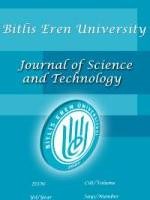The Possible External Factor Effecting On NO2 Molecule During Lightning Flash Under Corona Discharge
The Possible External Factor Effecting On NO2 Molecule During Lightning Flash Under Corona Discharge
Corona discharge, Lightning Flash, Electric Field, NO2 molecule Cloud,
___
- Bazelyan EM, Raizer YP, Aleksandrov NL (2008). Corona Initiated from Grounded Objects Under Thunderstorm Conditions and its Influence on Lightning Attachment, Plasma Sources Sci. Thechnol. 17: 024015. doi:10.1088/0963-0252/17/2/024015.
- Coleman LM, Marshall TC, Stolzenburg M, Hamlin T, Krehbiel PR et al. (2003). Effects of Charge and Electrostatic Potential on Lightning Propagation. Journal of Geophysical Research 108 (D9): 4298. doi:10.1029/2002JD002718.
- Fedotov VG, EYa F (2015). The Chain Reaction of Atmospheric Nitrogen Oxidation, Initiated by an Electric Discharge in Air, J. Phys. Chem. Biophysics, 5: 195. doi:10.4172/2161-0398.1000195.
- Franzblau E, Popp CJ (1989). Nitrogen Oxides Produced from Lightning, Journal of Geophysical Research, 94 (D8): 89-104. doi:10.1029/JD094iD08p11089.
- Frisch MJ, Trucks GW, Schlegel HB, Scuseria GE, Robb MA, et al. (2009). Gaussian 09, Revision A.1, Gaussian Inc., Wallingford CT.
- Grebenshchikov SY, Beck C, Flöthmann H, Schinke R, Kato S (1999). Unimolecular Dissociation of NO2. I. Classical Trajectory and Statistical Calculations on a Global Potential Energy Surface, J. Chem. Phys. 111: 619. doi.org/10.1063/1.479342.
- Hill RD, Rinker RG, Wilson HD (1980). Atmospheric Nitrogen Fixation by Lightning, Journal of Atmos. Sci. 37: 179-192. doi.org/10.1175/1520-0469(1980)037<0179:ANFBL>2.0.CO;2.
- Ivanov MV, Zhu H, Schinke R (2007). Theoretical Investigation of Exchange and Recombination Reactions in O(3P) + NO (2Π) Collisions, The Journal of Chemical Physics 126: 054304. doi.org/10.1063/1.2430715.
- Jacobson MZ and Streets DG. 2009. Influence of Future Anthropogenic Emissions on Climate, Natural Emissions and Air Quality. Journal of Geophysical Research 114: D08118. doi:10.1029/2008JD011476.
- Kherbouche F, Benmimoun Y, Tilmatine A, Zouaghi A, Zouzou N (2016). Study of a New Electrostatic Precipitator with Asymnetrical Wire-to- Cylinder configuration for Cement Particles Collection, Journal of Electrostatics 83: 7-15. doi.org/10.1016/j.elstat.2016.07.001.
- Kunova O, Nagnibeda E (2017). On the Influence of State-Resolved Rates of Zeldovich Reactions on Shock Heated Air Flow Parameters, J. Phys., Conf. Ser. 815: 012009. pp. 1-8.
- Lagzi I, Meszaros R, Gelybo G, Leelossy A (2013). Atmospheric Chemistry, Eötvös Lorand University, Consortium Members: ELTE Faculties of Science Student Foundation, ITStudy Hungary Ltd.
- Larossi S, Poscolieri M, Rafanelli C, Franceschinis D, Rondini A et al. (2011). The Measure of Atmospheric Electric Field.In G. Neri et al. (eds.), Sensors and Microsystems, Lecture Notes in Electrical Engineering 91, Springer Science+Business Media B.V, pp. 175-179.
- Levine IN (1995). Physical Chemistry. 4th Edition, McGraw-Hill, Inc., New York.
- MacGorman DR, Rust WD (1998). The Electrical Nature of Storms, Oxford University Press. Inc., 198 Madison Avenue, New York 10016.
- Michalski G, Jost R, Sugny D, Joyeux M, Thiemens M (2004). Dissociation Energies of Six NO2 Isotopologues by Laser Induced Fluorescence Spectroscopy and Zero-Point Energy of Some Triatomic Molecules, J. Chem. Phys. 121: 7153. doi:10.1063/1.1792233
- Rakov VA, Uman MA (2003). Lightining Physics and Effects. Cambridge University Press, Cambridge, CB2 2RU, UK.
- Riba JR, Morosini A, Capelli F (2018). Comparative Study of AC and Positive and Negative DC Visual Corona for Sphere- Plane Gaps in Atmospheric Air, Energies, 11: 2671. doi.org/10.3390/en11102671.
- Ripoll J-F, Zinn J, Jeffery CA, and Colestock PL. (2014). On the Dynamics of Hot Air Plasmas Related to Lightning Discharges: 1. Gas dynamics. J. Geophys. Res. Atmos., 119, 9196–9217.
- Salonen H, Salthammer T, Morawska L (2019). Human exposure to NO2 in School and indoor environments, Environment International, 130: 104887. doi: 10.1016/j.envint.2019.05.081.
- Sayos R, Oliva C, Gonzalez M (2002). New Analytical (2A’, 4A’) Surfaces and Theoretical Rate Constants for the N(4S) + O2 Reaction, Journal of chemical Physics, 117 (2): 670-679. doi.org/10.1063/1.1483853.
- Schumann U, Huntrieser H (2007). The global Lightning-Induced Nitrogen Oxides Source, Atmos. Chem. Phys., 7: 3823-3907. doi.org/10.5194/acp-7-3823-2007.
- Smirnov SE, Marapulets YV (2012). Influence of a Single Lightning Discharge on the Intensity of an Air Electric Field and Acoustic Emission of Near-Surface Rocks, Soild Earth, 3: 307-311. doi.org/10.5194/se-3-307-2012.
- Tuck AF (1976). Production of Nitrogen Oxides by Lightning Discharges, Quart. J. R. Met. Soc., 102: 749-755. doi.org/10.1002/qj.49710243404.
- Wolfram Research, Inc., (2019). Mathematica, Version 12.0, Champaign, IL.
- Yayın Aralığı: Yılda 2 Sayı
- Başlangıç: 2011
- Yayıncı: Bitlis Eren Üniversitesi
Birol BAŞER, Nazlı AKAY, Murat KÜRŞAT
The Possible External Factor Effecting On NO2 Molecule During Lightning Flash Under Corona Discharge
Ercan IŞIK, Ali Emre ULU, Mehmet Cihan AYDIN
Dynamic Conditional Dependence for Turkey Earthquake Data: CD Vine Copula Approach
Ayse KARAKAŞ, Aslıhan DEMİR, Sinan ÇALİK
Experimental and numerical analysis of weir structures in open channel flows
Ali Emre ULU, Mehmet Cihan AYDIN, Fevzi ÖNEN
An Accurate HOG based Exemplar Pyramid Method for Image Classification of Astragalus L. Taxa
İrfan EMRE, Türker TUNCER, Sengul DOGAN, Murat KÜRŞAT, Osman GEDİK, Yaşar KIRAN
